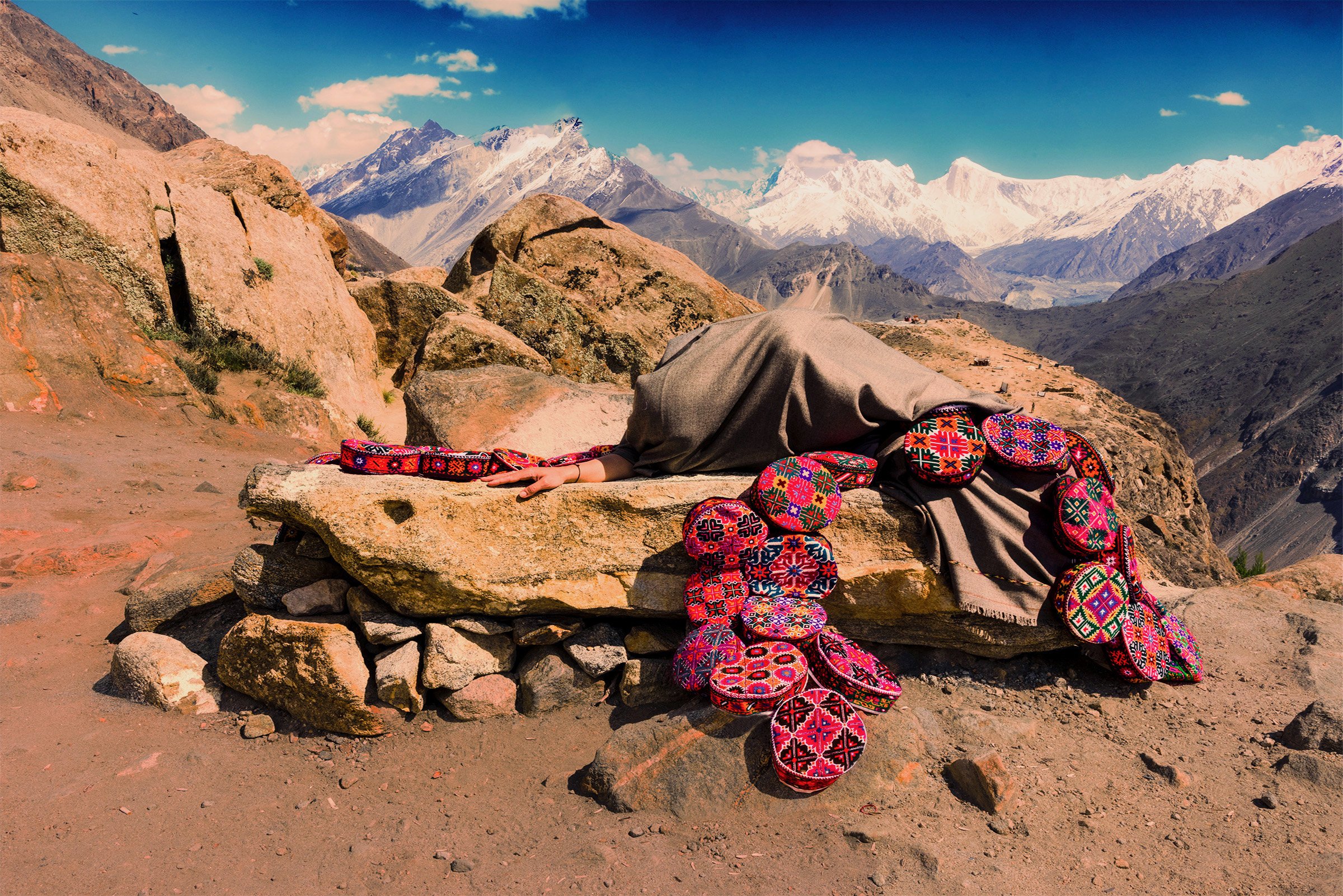Acts of Disappearance
2023
Digital photo prints of site-specific installations of hand embroidered Hunza caps at Attabad Lake and Eagles Nest, Gilgit-Baltistan, Northern Pakistan, 36” x 24” each.
The work is an offering. Honoring natural landscapes as sites of refuge, healing, and renewal. A reckoning with landscapes of displacement and erasure. And a song of survival, rising, and becoming. Of transcendence.
Gilgit-Baltistan, home to highest mountains and longest glaciers outside polar regions, is Pakistan’s most ethnically diverse region. Disproportionately shouldering ravages of climate change, 2010’s massive landslide buried Attabad villages, formed a desert of sand dunes and the Attabad Lake. Displaced Attabad people were forgotten, here evoked by traditional Hunza caps.
The territory is also suffering some of the greatest global damage from climate change. Over the past three years I have engaged the intertwined themes of eco-therapeutic art and contested land(scape). With an understanding that the land carries multiple burdens, my work acknowledges histories of indigenous habitancy, colonial settlement, and current ecological devastation. I explore themes of displacement and renewal, communal healing, and above all: the sublime, restorative potential of nature. My installations draw on transnational artistic roots to offer regenerative spaces, transcending boundaries of culture and place. The question of “Disappearance” is multivalent: the disappearing ecological system in the face of climate disaster, disappearances of activists who protest for social justice. Disappearance of indigenous bodies, and of labor - especially within the most economically impoverished regions, globally. Disappearance of women’s craft, of life-ways.
Installations in Gilgit-Baltistan & digital photography:
Unearthing Stories From The Core
Site-specific installations in Hunza, GB
where the eagles nested
and rocks eroded
where parts of our selves
erased and disappeared
out of our reach
leaving fragments behind
scattered inside, buried deep
yearning to be whole again
for the earth to heal us
and root us or lift us again
Site-specific installations by Attabad Lake, Hunza, GB
when the mountain fell, and the river stopped
its water rose, villages submerged
a cold desert of sand dunes formed
in the devastation a lake was born
resorts and tourists populated
the people of the mountain
forgotten and displaced, the Attabad IDPs
a colony of internally displaced people
far away from their home the land that sustained
and nourished them, now a tourist resort
Both Gilgit Baltistan and Oklahoma have resplendent landforms and historical parallels contribute to current struggle for political sovereignty. Oklahoma, now home to 39 federally recognized tribes, has been alternately dismissed and abused by America’s government. Once known as "Indian Territory,” it was the final destination of the devastating nineteenth-century Trail of Tears. Subsequent land grabs, violence against Black communities, and environmental destruction contribute to Oklahomans’ deeply fraught relationship with the land. Yet while frequently a site of conflict and contestation, Oklahoma’s earth is geographically extraordinary. The Tallgrass Prairie Preserve in Oklahoma is the largest protected piece of its kind left in the world.
Gilgit-Baltistan is the most ethnically and culturally diverse region in Pakistan. The ravages of climate change are contributing to a mental health crisis among indigenous and displaced populations. In 2010, in a massive landslide buried Attabad village; a cold desert of sand dunes formed the Attabad Lake. Now populated by resorts and the area’s biggest tourist attraction, the displaced people of Attabad were forgotten. As with the current struggles for tribal sovereignty within the US, the peoples of Gilgit-Baltistan campaign for recognition from Pakistan’s national assembly. While under the administration of Pakistan, the region hasn’t been given statehood status nor representation in Parliament.
By conceptually linking displaced populations in Pakistan and the US, Acts of Disappearance establishes a space for amplifying voices. It insists on a visceral understanding of ‘local’ environmental catastrophe as part of lager patterns.
This project is made possible with funding support from The Tulsa Artist Fellowship, and Creative Projects Grant funding from the Oklahoma Visual Arts Coalition.
© 2025 Sarah Ahmad. No content on this site may be used without permission. All Rights Reserved.


























































